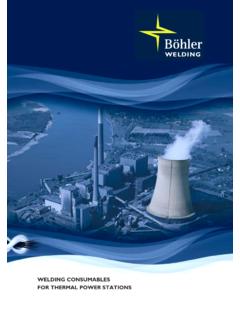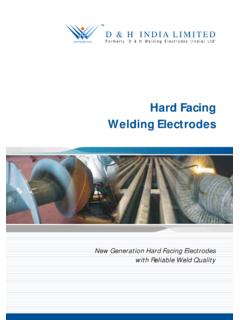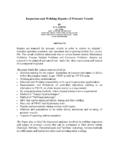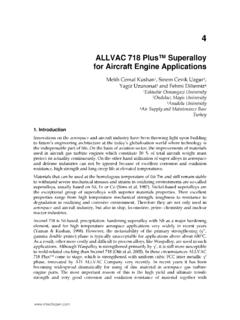Transcription of METAL POWDER AND CASTING RODS - …
1 METAL POWDER AND CASTING RODS. Top blade, welded with B HLER METAL POWDER Super DUR WC-P. with the plasma transferred arc welding process. (RWE Rheinbraun AG). Content Everything under control : The know-how of metallurgy, production technology and welding technology 4. Hardfacing and thermal spraying 8. METAL POWDER coating process 8. Plasma transferred arc welding (PTA) 8. Flame spray welding 10. Flame spraying 12. Plasma and high-velocity flame spraying (HVOF) 14. Hardfacing process with CASTING rods 16. Gas welding (O/A) 16. TIG welding 17. Typical properties of METAL POWDER coatings and hardfacing 18. Composition of B HLER METAL powders 19. Use of B HLER METAL powders 20. Deliverable grain sizes of B HLER METAL powders 21. Composition of B HLER CASTING rods 22. Use of B HLER CASTING rods 23. Deliverable dimensions of B HLER CASTING rods 24. Reference values for weld METAL hardness at room temperature and for elevated temperature hardness of the pure weld METAL 25.
2 Physical properties 26. Thermal expansion 26. Specific gravity, melting range and heat conductivity 26. Properties of coatings with B HLER METAL powders and CASTING rods 27. Corrosion behaviour of B HLER METAL powders and CASTING rods 28. Application of B HLER METAL powders and CASTING rods 29. Practical tips regarding hardfacing 30. 3. Everything under control : The know-how of metallurgy, production technology and welding technology For more than 75 years the B HLER THYSSEN. SCHWEISSTECHNIK Deutschland GmbH has dealt with the development and production of welding materials. An important application area of welding engineering is overlay welding, to give a work piece surface a special wear and/or corrosion resistance. B HLER offers a wide range of gas atomized METAL powders and CASTING rods on Co, Ni and Fe basis, which are suitable for hardfacing and thermal spraying. These products are manufactured to the highest standards.
3 The starting point is the production of alloyed ingots manu- factured in our steel foundry. This enables us to use our considerable experience gained over many years at an early stage of production. Filling the liquid METAL into the atomizing funnel. Temperature measurement during continuous CASTING . 4. For the POWDER production the ingots are liquefied in an induction furnace and brought to the gas atomization plant. The atomizing process is carried out in a closed container where a stream of molten METAL is atomized under high pressure with the aid of an inert gas, usually nitrogen. With this so-called gas atomization the speed of solidification is so slow that, during the time of the fall in the container, the drops formed during atomization are transformed into balls. The globular form of the grains guarantees excellent flow behavior and thus, good controllability of the POWDER supply. Wind screening for the POWDER grain size.
4 Continuous CASTING of the hardfacing rods. 5. The POWDER is also precipitated under inert gas. This guaran- the melt is washed during the process with shielding gas. The tees that the POWDER cools down without harmful surface rods are straightened and then separated to the length oxidation. Low oxygen contents of the METAL powders are requested by the customer. On request the surface of the the result. It is necessary to screen the POWDER to the requi- rod can be ground. red grain size before using the POWDER for spraying, plasma transferred arc welding or sintering. This is done in modern The METAL powders and CASTING rods are subjected to exten- screening units or air separators. sive quality controls. For determination of the chemical composition a laboratory with modern analytical equipment B HLER has a modern five-strand, horizontal continuous is used. Equipment for carrying out screen analyses as well CASTING machine for the production of hardfacing rods.
5 For as measurements of the flow rate, bulk density, hardness and this production, the ingots have to be liquefied in an induc- mechanical technological properties is part of the standard tion furnace the molten METAL is then decanted into a equipment of the laboratory. Tundish . To reach the optimal weld ability of the qualities, Straightening the CASTING rods. 6. Screen analyses instrument to determine the POWDER grain size. Optical emission spectrometer (OES) for the determination of the chemical analysis. View through a scanning electron microscope of gas atomized spherical METAL POWDER grains. 7. Hardfacing and thermal spraying METAL POWDER hardfacing process carrier gas for the POWDER . The POWDER grains can pass into the molten pool either in solid or molten form. This depends Plasma transferred arc welding (PTA) upon the size, the shape and the quantity of the grains, the This method is a plasma welding process with a continuous thermo-physical properties of the POWDER and the plasma, POWDER feeding.
6 The POWDER feeding may be added separa- as well as upon the transfer time of the POWDER grains in the tely as well as directly via the torch. plasma. The arc is initiated between the tungsten electrode and the Plasma transferred arc welding has gained increasing signifi- workpiece. It is ignited and stabilized simultaneously with the cance in recent years. This process facilitates a build-up of aid of a pilot arc between the tungsten electrode and the POWDER alloys, which in the form of rods or wire, are diffi- copper nozzle (anode). Main arc and pilot arc are supplied cult to produce or often cannot be produced. The advanta- independently from their own power source. The tungsten ges of plasma POWDER transferred arc welding is the precise electrode is enveloped in argon as a centre gas. Within the adjustment of the penetration depth and the build-up thick- arc, the argon is ionized forms a plasma with high beam ness (dilution) as well as the high energy density of the plas- energy.
7 Argon shielding gas is supplied via the outer nozzle. ma arc. Because of the continuous addition of POWDER , build- This shielding gas protects the molten pool against the up welds of uniformity and low porosity are produced so ingress of oxygen. The POWDER supply to the arc is carried that, in respect of mass production, a high degree of auto- out via a mechanical metering device. Argon is used as a mation is possible. Tungsten electrode Plasma gas: Ar/Ar+H2 Power HF source pilot arc Copper anode POWDER + POWDER gas Schematic diagram Water of a torch for plasma Power source transferred arc welding. Water main arc Pilot arc Shielding gas Main arc Ar Ar Welding seam Base material 8. B HLER METAL powders are used for hardfacing of bearing and sealing surfaces of gas, water, steam and acid fittings, also valve production for vehicle and shipping engines as well as for highly stressed and wear resistant hardfacing on hotwork, crushing, stirring, extracting and drilling tools.
8 The preheat and intermediate layer temperatures during the plasma transferred arc welding are dependant on the base material, the size of the workpiece and the number of layers. Plasma transferred arc welding of a continuous CASTING roll for steel production. Plasma transferred arc welding (hardfacing of a sealing surface). 9. Flame spray welding Flame spray welding is a surface coating process. From a short distance, via a torch the METAL POWDER is sprayed onto the base material and simultaneously fused. This produces fusion between the sprayed layer and the base material comparable to welding. With flame spray welding, the surface of the workpiece has to be cleaned thoroughly of rust, grease and oil. The roug- hening of the metallically clean surface should be effected by blasting or rough grinding in order to facilitate a good bond of the sprayed layer. Spraying should immediately be carried out after surface preparation.
9 This method is suitable for applying thin layers to small areas, edges and repair work. Low and high alloy steels, Flame spray welding with B HLER METAL POWDER Niborit 4-P. stainless steels, cast steels, malleable cast iron, flake and spheroidal graphite cast iron can be sprayed. POWDER based on with additions of Cr-Si-B and POWDER -mix qualities are available. Schematic representation of the flame spray welding. Spraying POWDER POWDER container Lever for POWDER supply Acetylene oxygen mixture Oxygen Nozzle Acetylene Flame Coating Adjust oxygen supply Adjust acetylene supply Base material 10. Flame spray welding with B HLER Niborit 5-P. 11. Flame spraying POWDER flame spraying can be divided into two processes: POWDER flame spraying is a coating process, during which the POWDER flame spraying without secondary thermal spraying POWDER is melted by means of an oxy-fuel gas flame treatment (cold spraying process).
10 And sprayed onto the surface of the workpiece. This process POWDER flame spraying with subsequent fusing-in is based upon a flame temperature of about 3,100 C. The (melt fusion). POWDER particles reach a speed up to 250 m/s, depending on particle size, spraying distance and operational data of the With flame spraying the surface of the workpiece has to be spray gun. Whilst passing through the flame, the POWDER cleaned thoroughly of rust, grease and oil before the real particles should be in a melted and/or plastic condition. base preparation. The roughening of the metallically clean Flame spraying with the B HLER METAL POWDER Niborit 6-P. 12. surface should be made by blasting or rough grinding to faci- litate a good bond with the sprayed layer. Spraying should immediately be carried out after the surface preparation. With POWDER flame spraying without secondary thermal treatment (called cold spraying process) a workpiece tempe- rature of up to 300 C is not exceeded, so that no changes in the structure of the component occur.







